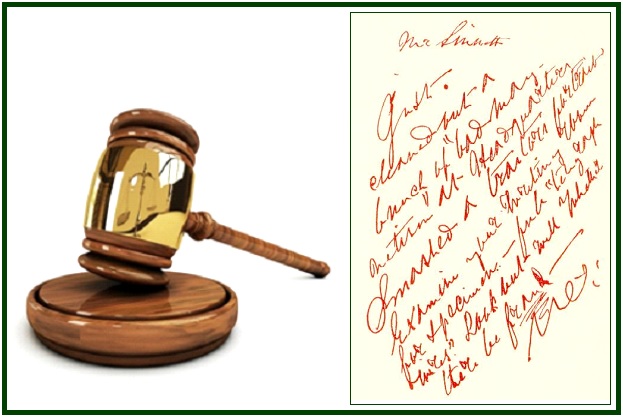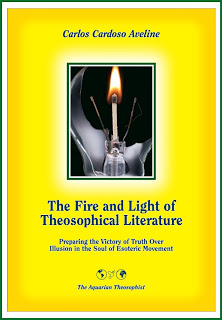
Why Theosophy Excludes
The Practice of Ceremonialism
Carlos Cardoso Aveline

On the right, the manuscript of a letter from a Mahatma
Being a universal philosophy, Theosophy transcends each and all of the sects, religions and philosophies now existing.
From the point of view of esoteric wisdom, the student himself is the very telescope through which he must look at life. This is one of the practical reasons why, in order to understand theosophy, the truth-seeker must have a clean life, an open mind and a pure heart.
Wisdom can only be obtained by merit. It is necessary to get rid of attachment to outer form, rituals and superstitious beliefs. And while this tenet is central to the original teachings of theosophy, it is totally ignored by the pseudo-theosophy fabricated by some leaders of the Adyar Theosophical Society between 1900 and 1934.
In “The Mahatma Letters”, one of the Raja-Yogis of the Himalayas mentions the illusion of “belief in the efficacy of vain rites and ceremonies; in prayers and intercession.” [1]
While discussing the same paragraph in the book “Early Teachings of the Masters”, C. Jinarajadasa adds this information:
“Of the ten ‘Fetters’ on the Path to liberation, the first three are: 1) Sakkayaditthi, the delusion of self; 2) Vichikicheha, doubt; 3) Silabbataparamasa, belief in the efficacy of rites and ceremonies.” [2]
In another paragraph of the same letter, the raja-yogi refers to a rite performed by high lamas in Tibet, many decades before the Chinese invasion of the 20th century, and a rite of which he himself, a Mahatma, would be a part. And the Master clarifies that even a ceremony of that level is no better than a meaningless superficiality, whose usefulness is limited to childish and scarcely advanced souls. The Master says:
“In about a week – new religious ceremonies, new glittering bubbles to amuse the babies with, and once more I will be busy night and day, morning, noon, and evening.” [3]
Esoteric philosophy gives its students tools with which they can liberate themselves from such delusions.
In the famous Letter of 1900, which was addressed to Annie Besant, a Master anticipates and warns against the main mistakes that the Adyar society would make from that moment on.
He clarifies that the modern theosophical movement was meant “to be the corner-stone of the future religions of humanity”. In order to accomplish this object, “those who lead” it, says the Master, “must leave aside their weak predilections for the forms and ceremonies of any particular creed and show themselves to be true Theosophists both in inner thoughts and outward observance”. [4]
The warning was useless to Annie Besant.
A few years after the warning, she adopted various rituals as tools to obtain political power in the esoteric movement. Besant and other false clairvoyants combined theosophy with masonry, promoted a “theosophical catholic church” and started organizing the “return of the Christ” through the person of Jiddu Krishnamurti.
For almost two decades, Krishnamurti willingly played the theatrical role of “Jesus Christ” while was manipulated by Annie Besant. He finally abandoned the Society of Adyar in 1929, closing the main and more visible part of the tragic comedy of a Besantian Avatar.
Olcott, On Attachment to Outer Forms
North-American thinker Henry S. Olcott was one of the main founders of the Theosophical Movement in 1875. In his book “Buddhist Catechism” one finds this question:
“What was the Buddha’s estimate of ceremonialism?”
And Olcott answers:
“From the beginning, he condemned the observance of ceremonies and other external practices, which only tend to increase our spiritual blindness and our clinging to mere lifeless forms.” [5]
In one of the Letters from Mahatmas, a Master says it is impossible to perform good ceremonial magic in the West. He narrates the frustrating result of “the last attempt” in that direction, in London around 1860, of which meetings the master took part in “about half a dozen” occasions. The meetings were led by Edward Bulwer-Lytton and included Eliphas Levi, Regazzoni and other occultists. [6]
Vain Rituals and Empty Ceremonials
While explaining the deeper meaning of the word “Buddhist”, a sage of the Himalayas wrote:
“Many prefer to call themselves Buddhists not because the word attaches itself to the ecclesiastical system built upon the basic ideas of our Lord Gautama Buddha’s philosophy, but because of the Sanskrit word ‘Buddhi’ – wisdom, enlightenment; and as a silent protest to the vain rituals and empty ceremonials, which have in too many cases been productive of the greatest calamities. Such also is the origin of the Chaldean term Mage.” [7]
“Isis Unveiled” is among the most important works written by Helena P. Blavatsky. There we can see her critical approach regarding the modern masonic rites. HPB reveals that modern masonry was widely infiltrated. Its rituals were changed and adulterated by the Jesuits, which played the role of espionage agency in charge of undercover operations for the Vatican.[8]
In the article “The Beacon of the Unknown”, H.P. Blavatsky refers to the original Theosophical Society (T.S.) which ceased to exist due to Annie Besant’s betrayal in the 1890s:
“Having neither dogma nor ritual – these two being but fetters, a material body which suffocates the soul – we do not employ the ‘ceremonial magic’ of the Western Kabalists; we know its dangers too well to have anything to do with it. In the T.S. every Fellow is at liberty to study what he pleases, provided he does not venture into unknown paths which would of a certainty lead him to black magic, the sorcery against which Eliphas Levi so openly warned the public.” [9]
In the first half of the 21st century, a large section of the theosophical movement still does not see the importance of the words quoted above. However, a small and significant part of the movement has remained away from blind belief and available to free thinking. It is possible to imagine a future moment when most of theosophical associations will have rejected ritualistic structures, being organized instead in more spontaneous ways around the authentic teachings. This is how a few theosophical groups see even now the future of the esoteric movement.
Even the Adyar Society is making progress in that direction, although in such a slow way that cannot be easily detected. According to an old popular saying, “a lie has short legs”. While the false theosophy of Annie Besant and C. W. Leadbeater is gradually abandoned, the number grows of Adyar theosophists who discover the permanent value of true theosophical literature and focus their attention on the teachings of the Masters and Helena Blavatsky.
As time passes, the speed of this process undergoes an acceleration, which is beneficial to the esoteric movement as a whole. There is no need to spend one hundred years more in the process of abandoning the old illusions created by false clairvoyants during the first half of the twentieth century.
NOTES:
[1] Letter XVI, page 111 in “The Mahatma Letters”, TUP edition, Pasadena, CA, USA.
[2] “Early Teachings of the Masters (1881-1883)”, C. Jinarajadasa, Kessinger Publishing Co., USA, facsimile edition of the TPH-India 1923 edition, 245 pp., see p. 61.
[3] Letter XVI, page 116 in “The Mahatma Letters”, TUP edition, Pasadena, CA, USA.
[4] See in our associated websites the article “The 1900 Letter From a Mahatma”. The Letter is also part of the volume “Letters From the Masters of the Wisdom”, first series, edited by C. Jinarajadasa, TPH, 1973, Letter 46.
[5] “Buddhist Catechism”, by H. S. Olcott, various editions, question and answer number 184, in Part II.
[6] “The Mahatma Letters”, TUP ed., Pasadena, CA, Letter XXVIII, pp. 209-210.
[7] “The Mahatma Letters”, TUP edition, Pasadena, CA, see Letter LXXXV, p. 399. In the chronological edition, see Letter 120.
[8] See “Isis Unveiled”, Theosophy Co., Los Angeles, volume II, pp. 381-391, among others.
[9] “Collected Writings”, H.P. Blavatsky, TPH, Adyar, India, volume XI, p. 266.
000
On the role of the esoteric movement in the ethical awakening of mankind during the 21st century, see the book “The Fire and Light of Theosophical Literature”, by Carlos Cardoso Aveline.

Published in 2013 by The Aquarian Theosophist, the volume has 255 pages and can be obtained through Amazon Books.
000